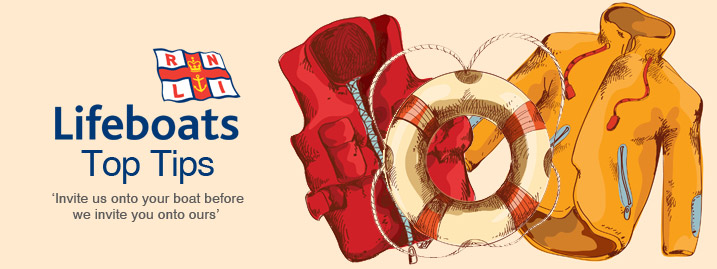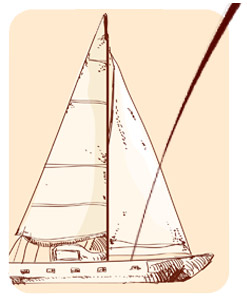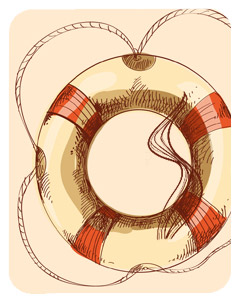
RNLI Top Tip 4 – Be prepared for things going wrong
Calling for help
A VHF radio provides the most reliable means of making immediate contact with the Coastguard and alerting other vessels if there is an emergency.
You must know how to operate your VHF radio. The RYA administers the Short Range Certificate (SRC); a one day course including routine, safety, urgency and distress communications and radio voice procedures and techniques. Most radios will be equipped with Digital Selective Calling (DSC) allowing a distress alert to be transmitted to the rescue services at the touch of a button. If your VHF radio is interfaced with a GPS it will also give your position.
If you use a waterproof, hand-held VHF, check the batteries and always carry a set of spares. Make sure everything is working by doing a ‘radio check’ with a marine, harbour master or coastguard.
A mobile phone with a waterproof case may be useful on a PWC or small dinghy. In an emergency dial 999 or 112 and ask for the Coastguard. The service is free and the Coastguard is always there to help. It should not, however, be relied upon in emergencies. It may let you down with no signal in a ‘dead area’ and it will not show the rescue services your position. A hand held VHF radio is a better option.
Lifesaving Signals
There is an internationally agreed set of lifesaving signals for use in distress in the Safety of Life at Sea (SOLAS) regulations, Chapter V. You must have a copy of the signals to be used when communicating with search and rescue units. Almanacs and the Admiralty Leisure charts and folios contain a copy and you can also obtain one from the MCA.
First Aid
It is advisable that at least one crew member on the vessel has a basic understanding of first aid. A comprehensive first aid kit and basic first aid knowledge could prove invaluable while you wait for professional assistance to arrive. The RYA runs first aid courses specifically marine orientated.
Fire Extinguishers
Fire extinguishers and fire blankets must be checked and maintained in line with manufacturer’s recommendations. Make sure they are stowed correctly, are fully accessible and that every crew member knows when to use them. Generally an extinguisher should be mounted next to every exit from the vessel (fore hatch, companion way and any other hatches or doors). In addition to servicing it would be beneficial to occasionally take any dry powder extinguisher out of its bracket and to give it a shake, before refitting. This stops the powder going solid at the bottom to the cylinder.

Flares
Flares are an essential part of your safety equipment. There are several types of flares on the market designed for different water users. For coastal journeys and beyond you should carry a full flare kit including rockets, hand-held flares and smoke flares. Firing flares is a simple method of indicating that a boat and/or person is in distress, and of drawing attention to your position when the rescue services are coming to your aid.
Make sure you know how to operate your flares before you need them. Firing mechanisms vary, so read the instructions printed on the sides. A tip when firing - if the writing is upside down, so is the flare.
Leisure flares expire after 4 years. After this date they will deteriorate and become less reliable. Replace expired ones with new ones. Some suppliers will also accept expired ones, but please recognise the value- added service they are providing by purchasing your replacements from them at the same time. The Coastguard may take leisure craft quantities for onward disposal.
White collision-avoidance flares should be located immediately inside a companionway for rapid use. Keep the others with a torch and a pair of gloves in a readily accessible, watertight, screw-top container. To aid identification at night, pair up the red pinpoint flares and tape them together. Rocket parachute flares stand out because of their length. Buoyant orange smoke flares are short and dumpy. With the reds paired and whites located else where, the remaining flares in the container must be the hand-held orange smokes.
Don’t start to prepare a flare unless you are sure you’re going to fire it. Once prepared for firing many are vulnerable to accidental firing as the caps/triggers cannot be made safe again. It is illegal to fire a distress flare when not in distress.
Firing Flares
- Hold hand-held flares over the downwind side of your boat with your arm fully outstretched and turn your face away.
- Point them away from yourself, anyone else and the superstructure of the vessel.
- Hold at an angle of 45° to 60° to allow any dross from the flare to fall clear of your hands.
- Hand held flares become extremely hot so wear gloves if possible.
- Rocket flares must not be used when a helicopter or aircraft is overhead.
- Orange smoke flares are the most effective for daytime use.
- Red flares are most effective at night.
Rescue Lasers?
Initial reaction was - these seemed to be a sensible way forward. Magazine tests unfortunately show a very poor performance. Helicopter crews are very wary, as at night they could potentially overpower their night vision goggles. Would you like a 15 ton helicopter overhead for three minutes while the pilot waits for his vision to return?

Man Overboard Drill
A significant number of RNLI services are to rescue people who have fallen overboard. Even on a calm day it is easy to trip over a loose line or sail, or be thrown out of the vessel if the helmsman accelerates or turns unexpectedly. In the event of a man overboard everyone on board must know what to do. If only the skipper knows the drill and goes overboard, they could be lost, if no one else is able to control the vessel. There are several different techniques that can be used to return to a man overboard under power or sail. It can be very difficult. Practice these to see which works best for you and your crew.
Man Overboard Recovery
If one of your crew has fallen overboard it is vital that you do not loose sight of them. Make sure you do the following:
- At least one crew member must keep pointing at the person in the water to keep track of them.
- Get some buoyancy and markers into the water.
- Press the MOB button on your GPS set.
- Tell the coastguard, even if you are sure that you can retrieve them. Help can always be stopped if you are successful, but if it takes longer than expected or proves difficult, then help is already on its way. The rescue services would rather turn back than arrive too late.
When approaching the casualty:
- Never allow a rotating propeller to get near them.
- Ensure the engine is in neutral and stop the engine if it is safe to do so (prevents anyone catching the control in error).
Follow Up
If you want to follow up any of these points or have any other sea safety issues don’t hesitate to contact the Lifeboat Sea Safety Officer at your local Lifeboat station. If there is not one appointed yet the station can give you a contact in a nearby station who will be only to happy to help in any way. Free sea safety advice is always available.
‘Invite us onto your boat before we invite you onto ours’
Read More
Thanks to the author, PT Corner, for permission to publish this article.